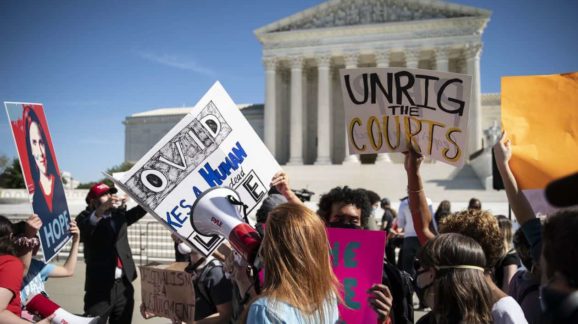Democrats Assured ACA Would Come Before ACB
California and the House asked the Supreme Court to fast-track’s Texas’ challenge to the law.
Democrats now claim they oppose Judge Amy Coney Barrett’s confirmation because they fear she will overturn the Affordable Care Act in California v. Texas, which is scheduled for oral argument on Nov. 10. But the case is before the Supreme Court now only because Democrats insisted that the justices consider the case straightaway. Their rush precluded a more careful reconsideration that almost certainly would have preserved much or all of the law.
The 2012 Supreme Court decision upholding the ACA, NFIB v. Sebelius, found that the individual mandate couldn’t be justified under the constitution’s Commerce or Necessary and Proper clauses, but could be upheld as an exercise of Congress’ taxing power. Texas, 17 other states, and two individuals argued that since the 2017 Tax Cuts and Jobs Act set the mandate penalty at zero starting in 2019, it no longer produces revenue and is no longer a tax. Therefore, the plaintiffs say, the mandate and the entire law are unconstitutional. The federal government didn’t oppose the action, but California, 16 other states and the District of Columbia were allowed to intervene to defend the ACA.
A district court agreed the mandate was no longer a tax and was therefore unconstitutional. Because the mandate was an essential part of the law, the court said, it wasn’t “severable,” rendering the entire law unconstitutional.
The Fifth U.S. Circuit Court of Appeals allowed the Democrat-controlled House to intervene to defend the ACA on appeal. The circuit court affirmed that the mandate was no longer constitutional but remanded the case to the district court to “conduct a more searching inquiry into which provisions of the ACA Congress intended to be inseverable from the individual mandate.”
Instead, the defending states and the House petitioned the Supreme Court for immediate review. Over the objections of the federal government and the plaintiff states, the justices agreed to hear the case.
Had the process played out without early Supreme Court intervention, it would have taken at least a year for the district court to rule and the Fifth Circuit to review the issue of severability. Meanwhile, the ACA would have remained in effect.
The Fifth Circuit clearly thought few, if any, of the law’s provisions were inseparable from the mandate. It held the district court decision “inappropriately focuses on the 2010 Congress’ labeling of the individual mandate as ‘essential’ to its goal of ‘creating effective health insurance markets,’ . . . to designate the entire ACA inseverable.” The district court should instead have focused on the intent of the 2017 Congress that repealed the mandate penalty and done the “legwork” of explaining how parts of the law are inextricably linked to the mandate and therefore unconstitutional.https://tpc.googlesyndication.com/safeframe/1-0-37/html/container.html
The ACA has 10 titles and a multitude of provisions, most of which have nothing to do with the mandate. The severability analysis the Fifth Circuit instructed the district court to undertake would likely have concluded that most provisions could be severed from an unconstitutional mandate found in Title I.
The mandate had little effect even before Congress zeroed out the penalty. The original ACA undermined it by exempting many people and setting the penalty low. Adherence was self-reported on tax returns and barely enforced—the Internal Revenue Service never rejected “silent returns” on which the taxpayers failed to report if they purchased insurance. Those who failed to pay the penalty weren’t prosecuted.
The four dissenting justices in NFIB v. Sebelius believed that the mandate was an essential part of the ACA and couldn’t be severed from the statute. Yet many of experts who argued in 2012 that the market couldn’t function without the mandate and penalty now acknowledge in a friend-of-the-court brief that it was clear by 2017 the penalty wasn’t necessary. The stability in premiums, enrollments and risk pools following the 2019 penalty elimination “undercuts the once widely held view that the ACA’s market rules, including guaranteed issue, and modified community rating, would be unsustainable in the absence of an individual mandate.” Based on their instructions to the district court and on accumulating real-world evidence, the Fifth Circuit would likely have found these protections severable from the now-unconstitutional mandate. The Supreme Court would have likely affirmed such a ruling, if it took up an appeal at all.
Protections for people with pre-existing conditions would have continued while the judicial process played out. Instead, congressional Democrats and their allies in state governments sought immediate Supreme Court review, perhaps anticipating review while Justice Ruth Bader Ginsburg was still on the court. If there is a coming health-insurance crisis, as Democrats claim, it is one of their own invention.
Dr. Zinberg, a surgeon and a lawyer, is a senior fellow at the Competitive Enterprise Institute and an associate clinical professor of surgery at the Icahn Mount Sinai Medical School in New York. He served as senior economist and general counsel at the Council of Economic Advisers, 2017-19.
